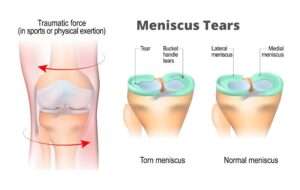A meniscus injury refers to damage or tears in the meniscus, which is a C-shaped cartilage found in the knee joint. Although karate is not typically associated with a high risk of meniscus injuries compared to sports like football or basketball, it is still possible to sustain such an injury while practicing or competing in karate.
The meniscus acts as a shock absorber and provides stability to the knee joint. It can be injured due to a variety of reasons, including twisting, sudden changes in direction, pivoting, or direct impact on the knee. In karate, certain techniques such as kicks or takedowns may put stress on the knee joint and increase the risk of meniscus injuries if performed incorrectly or with excessive force.

Common symptoms of a meniscus injury include pain, swelling, stiffness, locking or catching sensation in the knee joint, and difficulty fully bending or straightening the leg. When a knee injury occurs, there is typically no doubt. The pain can be excruciating (actually it can hurt like he..). I can personally attest to that from my own experience. If you suspect a meniscus injury, it is important to seek medical attention for proper diagnosis and treatment.
Treatment options for meniscus injuries vary depending on the severity and location of the tear. In some cases, conservative measures such as rest, ice, compression, elevation (RICE), and physical therapy may be sufficient for healing. However, more significant tears or cases that do not respond to conservative treatment may require surgical intervention. The surgical options include meniscus repair, where the torn edges are stitched together, or meniscectomy, where the damaged portion of the meniscus is removed.
The RICEM principle
Step 1: Rest (rest and tranquillity)
Step 2: Ice (cooling of the injury that counteracts swelling and pain)
Step 3: Compression (compression, bandaging with moderate pressure to prevent swelling)
Step 4: Elevation (elevation of the arm or leg also prevents swelling and relieves pain)
Step 5: Mobilization (Do not lie on the couch forever; you have to get going again)
To prevent meniscus injuries in karate, it is crucial to maintain proper technique and body mechanics while performing techniques. Additionally, incorporating strength and flexibility exercises for the lower body, particularly the muscles around the knee joint, can help improve stability and reduce the risk of injuries.
By the way, I am not a medical professional. If you are dealing with a meniscus injury, it is important to consult with a qualified healthcare provider or sports medicine specialist for an accurate diagnosis and appropriate treatment recommendations.
Be safe, and thanks for reading.
Gert
